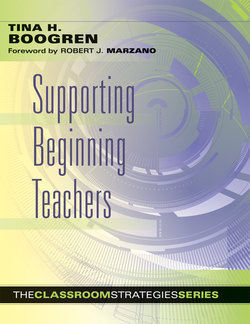Читать книгу Supporting Beginning Teachers - Tina H. Boogren - Страница 11
На сайте Литреса книга снята с продажи.
ОглавлениеChapter 2
DESIGNING AN EFFECTIVE MENTORING PROGRAM
The word mentor comes from Homer’s Odyssey, which tells the story of the Greek hero Odysseus and his voyage home after the fall of Troy (Brockbank & McGill, 2006). During his absence, Odysseus entrusts his son, Telemachus, to a wise friend named Mentor. While he does not replace Odysseus as a parent, Mentor does become a counselor, guardian, and guide to Telemachus. He offers the young man support, inspires him to face challenges, and helps him understand and embrace the difficulties that lie ahead.
Teacher mentors must fulfill a similar variety of roles in their work and relationships with beginning teachers. According to Laura Lipton and Bruce Wellman (2001), effective mentors offer comfort, create challenge, and facilitate a professional vision. They explained, “These functions can operate independently in specific situations, but in the greater context of the relationship they must be connected. Balancing these three elements energizes growth and learning” (p. 1). For example, it is important to help new teachers feel comfortable, but offering comfort without challenge may eventually foster complacency. Creating challenge without offering comfort, on the other hand, can heighten feelings of anxiety and failure. Offering comfort and creating challenge without facilitating vision can leave new teachers without a feeling of larger purpose, looking only at the ground beneath them but not at the road ahead.
When supporting beginning teachers, school leaders must provide more than a basic back-to-school orientation or a randomly selected partnership with an experienced teacher. In light of the complexities of the mentoring role, school leaders must carefully select mentors, support them as they develop relationships with mentees, and give them concrete guidance about the types of support they are expected to offer new teachers. Therefore, the mere presence of a randomly selected mentor is not enough. School leaders should design mentoring programs with three components in mind.
1. Selection of high-quality mentors
2. Effective relationships between mentors and mentees
3. Specific types of new-teacher support
The following sections describe the importance of each of these components, as well as strategies school leaders and mentors can use to develop a foundation for supporting beginning teachers.
Selection of High-Quality Mentors
The first component of an effective mentoring program is the selection of high-quality mentors. School leaders must carefully and intentionally select mentors and thoughtfully pair them with beginning teachers (Moir et al., 2009). There are a number of reasons for this. First, a mentor who teaches the same subject or grade level as a beginning teacher can provide advice specific to a mentee’s classroom needs. A fifth-grade mentor teacher, for example, is probably not the most useful fit for a new kindergarten teacher. Second, carefully chosen pairings can help foster a mutually beneficial relationship between mentor and mentee. Bob Garvey (2010) asserted that “genuine and authentic intent is an essential ingredient for mentoring and coaching within an organization because holistic development is only achievable in a wholesome and honest environment” (p. 351). Finally, a well-matched pair not only benefits the mentee but also the mentor teacher and the organization—in this case, the school—as a whole.
The mentee benefits from improving his or her performance, productivity, confidence, and general well-being, as well as from gaining opportunities for career networking and advancement. The mentor gets satisfaction from helping another teacher grow and develops new leadership skills, knowledge, and self-awareness. The school as a whole benefits because well-matched mentor-mentee pairs promote staff retention, foster motivation among teachers, and improve schoolwide communication, learning, and morale. Seeking to establish thoughtful, purposeful mentoring pairings can help attain these benefits.
